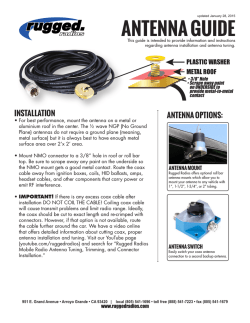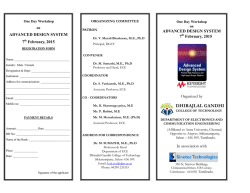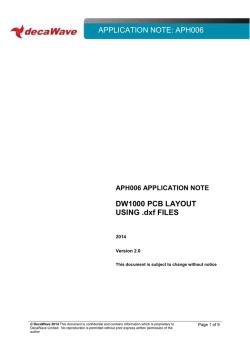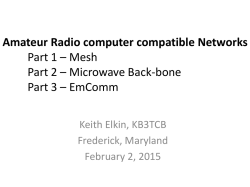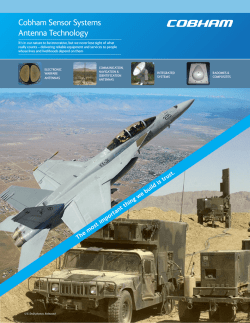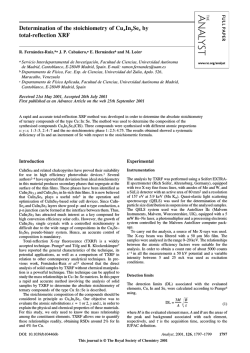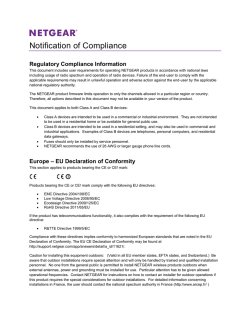
APPLICATION NOTE: APS014
APPLICATION NOTE: APS014 APS014 APPLICATION NOTE ANTENNA DELAY CALIBRATION OF DW1000-BASED PRODUCTS AND SYSTEMS Version 1.01 This document is subject to change without notice © DecaWave 2014 This document is confidential and contains information which is proprietary to DecaWave Limited. No reproduction is permitted without prior express written permission of the author APS014: DW1000 Antenna Delay Calibration TABLE OF CONTENTS LIST OF TABLES ............................................................................................................................ 2 LIST OF FIGURES........................................................................................................................... 2 1 INTRODUCTION ..................................................................................................................... 3 1.1 1.2 2 OVERVIEW ................................................................................................................................... 3 ABOUT THIS DOCUMENT................................................................................................................. 4 ANTENNA DELAY CALIBRATION ............................................................................................. 5 2.1 APPLICATION REQUIREMENTS ......................................................................................................... 5 2.1.1 Ranging Method and Antenna Delay Calibration ............................................................. 5 2.1.2 Accuracy ............................................................................................................................ 6 2.1.3 Temperature Variation ...................................................................................................... 6 2.2 REFERENCE DEVICE GENERATION ..................................................................................................... 6 2.2.1 TWR Antenna Delay Calibration Reference Device Generation ........................................ 6 2.2.2 TWR Antenna Delay Calibration Reference Device Generation Example........................ 10 2.3 ANTENNA DELAY CALIBRATION USING A KNOWN REFERENCE DEVICE .................................................. 11 2.3.1 Using Wired Channels in Antenna Delay Calibration Setups........................................... 11 2.3.2 Antenna Delay Calibration Using TWR with a Reference Device .................................... 11 2.3.3 Antenna Delay Calibration for an RTLS Environment ...................................................... 11 3 GLOSSARY ........................................................................................................................... 13 4 REFERENCES ........................................................................................................................ 14 4.1 5 LISTING ..................................................................................................................................... 14 ABOUT DECAWAVE ............................................................................................................. 14 LIST OF TABLES TABLE 1 : ANTENNA DELAYS REQUIRED BY RANGING REQUIREMENTS ................................................................. 5 TABLE 2 : DW1000-BASED EVK1000 ANTENNA DELAY CALIBRATION BASED ON STANDARD DEVIATION OF ANTENNA DELAY VARIATION AND REQUIRED LOCATION ACCURACY .............................................................................. 6 TABLE 3: EXAMPLE ANTENNA DELAY CALIBRATION EDM POPULATION ............................................................... 10 TABLE 4: PERCENTAGE TRANSMIT AND RECEIVE ANTENNA DELAY IN TOTAL AGGREGATE DELAY................................ 12 TABLE 5: GLOSSARY OF TERMS..................................................................................................................... 13 TABLE 6: TABLE OF REFERENCES .................................................................................................................. 14 LIST OF FIGURES FIGURE 1: ANTENNA DELAY DIAGRAM ............................................................................................................ 3 FIGURE 2: TWR REFERENCE DEVICE GENERATION SETUP .................................................................................... 7 FIGURE 3 : TWR ANTENNA DELAY CALIBRATION ALGORITHM - OVERALL FLOWCHART ............................................. 8 FIGURE 4: POPULATE THE SET OF CANDIDATE DELAY ESTIMATES - FLOWCHART ...................................................... 9 FIGURE 5: EVALUATE THE QUALITY OF THE CANDIDATES - FLOWCHART ............................................................... 10 © DecaWave 2014 This document is confidential and contains information which is proprietary to DecaWave Limited. No reproduction is permitted without prior express written permission of the author Page 2 of 14 APS014: DW1000 Antenna Delay Calibration 1 INTRODUCTION 1.1 Overview DecaWave’s DW1000, a multi-channel transceiver based on Ultra Wideband (UWB) radio communications, allows very accurate time-stamping of messages as they leave from and arrive at the transceiver. The delays which are measured in these timestamps include the propagation delay through the DW1000 devices from the points at which the transmitter timestamps are applied to the points at which the receiver timestamps are captured. These delays are referred to as the transmit/receive antenna delays. These antenna delays are internal to the chip and not included in the Time of Flight (ToF) but are included in the propagation delay from transmission timestamp to receive message timestamp, see Figure 1. Refer to [2] for more information on timestamps. When measuring the Time of Flight (ToF) from a transmitter to a receiver the delay measured includes the antenna delays (see Figure 1): where: ToF tMeasured tADTX tADRX = = = = Time of Flight The measured time from the transmit timestamp to the receive timestamp Transmit antenna delay Receive antenna delay To find the Time of Flight, we need to know the transmit and receive antenna delays. Antenna tADTX DW1000based product or system 2 tADRX External RF RF Switch DW1000based product or system 1 Antenna tADTX tADRX External RF Transmit timestamp applied Analog TX Analog RX Digital TX Digital RX Receive timestamp captured RF Switch DW1000 Transmit timestamp applied Analog TX Analog RX Digital TX Digital RX Receive timestamp captured Host Interface DW1000 Host Interface Figure 1: Antenna Delay Diagram © DecaWave 2014 This document is confidential and contains information which is proprietary to DecaWave Limited. No reproduction is permitted without prior express written permission of the author Page 3 of 14 APS014: DW1000 Antenna Delay Calibration The internal propagation delays in DW1000 devices vary slightly from chip to chip. There can also be variations due to components between DW1000 and the antenna. Since we are measuring RF signals moving at the speed of light these variations can make differences to ranging measurements in the tens of centimeters. Antenna delay calibration is used to remove these variations. 1.2 About this document This document is intended to be read together with [4] which gives a guide to production testing and calibration for DW1000-based products to understand how to integrate antenna delay calibration into the production test environment. The document is divided into three main sections: A description of antenna delay and application requirements. How to generate a reference device for antenna delay calibration. How to carry out antenna delay calibration using reference devices on the production line. © DecaWave 2014 This document is confidential and contains information which is proprietary to DecaWave Limited. No reproduction is permitted without prior express written permission of the author Page 4 of 14 APS014: DW1000 Antenna Delay Calibration 2 ANTENNA DELAY CALIBRATION Depending on the accuracy needed in an application, antenna delay calibration may or may not be required. Table 1 shows the accuracy that can be expected with and without calibration. Antenna delay calibration should be carried out using the exact use case(s) that will be used in the final application. For example; PRF, channels, and power-up modes. You should refer to [3] for a detailed treatment of the sources of error in TWR. 2.1 Application Requirements Two-Way Ranging (TWR) is the calibration method described in this document for all applications including TDoA applications. 2.1.1 Ranging Method and Antenna Delay Calibration Depending on whether TWR, Time difference of Arrival (TDoA) and on whether wireless or wired synchronization is required in the final application, the system will need different antenna delay information. For a TWR system, the aggregate antenna delay (the sum of the transmitter and receiver antenna delay) is required in the calculations. Where antenna delay calibration is required, both anchors and tags should be calibrated. In a TDoA system using wired synchronization, the receiver (anchor) antenna delay only is required. In a TDoA system using wireless synchronization, the individual transmitter and receiver delays is required. Table 1 summarises the system ranging requirements and the associated types of antenna delays needed. Table 1: Antenna Delays Required by Ranging Requirements Application Type Antenna Delays Needed TWR Aggregate (sum of) transmitter and receiver antenna delays. Both anchors and tags require calibration if calibration is being carried out. TDoA / Wired Synchronization Receiver antenna delay, calibrate anchors only, if calibration is being carried out. TDoA / Wireless Synchronization Both transmitter and receiver antenna delays are needed in systems that are required to perform wireless synchronization. Calibrate anchors only, if calibration is being carried out. DecaWave calibrates antenna delay using a method described below using TWR. For that reason, devices which are intended to be calibrated for antenna delay using this method must be capable of acting as a transmitter and as a receiver. If the device to be calibrated includes an LNA, for example, a transmit path must be included in order to carry © DecaWave 2014 This document is confidential and contains information which is proprietary to DecaWave Limited. No reproduction is permitted without prior express written permission of the author Page 5 of 14 APS014: DW1000 Antenna Delay Calibration out TWR for antenna delay calibration. 2.1.2 Accuracy Whether antenna delay calibration is needed for a product depends on the location accuracy required in the application and on the antenna delay variation observed between parts. Ranging data for 2000 DW1000-based DecaWave EVB1000’s was analysed to find the standard deviation of the antenna delay variation before and after the EVB1000’s had been calibrated. The 3-sigma variation (99.7% of samples) of the antenna delay was found to be 30 cm before calibration and 4.5 cm after calibration. So, applications requiring accuracy of 30 cm or less do not require any per-board antenna delay calibration. For such applications, a default value must be worked out during product characterization using a statistically significant sample. If the EVB1000’s were calibrated for antenna delay, the best accuracy achievable would be 4.5 cm. See Table 2. Table 2: DW1000-based EVK1000 antenna delay calibration based on standard deviation of antenna delay variation and required location accuracy TWR Accuracy Required 2.1.3 Example Antenna Delay Calibration Recommended 30 cm No per-board antenna delay calibration needed 4.5 cm Calibration using known reference device(s) Temperature Variation The antenna delay will vary with temperature. It is recommended that the temperature at which calibration was carried out is recorded. This will allow the application to adjust measurements if required. Range has been shown to vary by 2.15 mm / °C (or 7.17 ps / °C) per device for DW1000 devices. 2.2 Reference Device Generation To carry out antenna delay calibration on a production line as described in section 2.3, a known reference device is required. Before the production calibration can be carried out it is necessary to have a reference device. 2.2.1 TWR Antenna Delay Calibration Reference Device Generation This calibration method gives accurate measurements of aggregate transmitter and receiver antenna delay. This method is performed by carrying out TWR using at least three devices. A Euclidean Distance Matrix (EDM) is constructed using ranges obtained using TWR, having set the antenna delay to zero. The device temperature should be noted. A Euclidean Distance Matrix is an n x n matrix representing the spacing of a set of n points in Euclidean space (3-D space in this case). To construct an EDM suitable for this antenna delay calibration with devices numbered 1 to n, the average ranges for each pair © DecaWave 2014 This document is confidential and contains information which is proprietary to DecaWave Limited. No reproduction is permitted without prior express written permission of the author Page 6 of 14 APS014: DW1000 Antenna Delay Calibration permutation are entered in the matrix: [ ] where: The entries along the diagonal are always zero; the distance from device 1 to device 1 is zero. The other entries are filled with the ranges measured by TWR between each pair of devices used. The actual distances must be known; measure the actual distances between devices. The distances between devices should be the same, or close to the same so that treatment of the range bias (see [3] for a full description of range bias) in the calculations is simplified. See [4] for a description of how to use a known wired channel instead of an over the air channel. The devices can be arranged as shown in Figure 2 or the paired measurements can be done in turn using two devices at a time. Keeping the distances between the devices the same is recommended. Host running DecaRanging DW1000-based device 1 Equidistant free space/ known wired channels DW1000-based device 2 Host running DecaRanging Antenna for free space OR test port for known wired channel Host running DecaRanging DW1000-based device 3 Figure 2: TWR reference device generation setup The antenna delays can be determined by minimizing the norm of the difference between the two EDM’s: ( ) where is given by the known distances between the devices in the calibration array as measured using a laser range finder or other calibrated measuring device and is given by the ranges measured using the DW1000-based devices performing TWR. © DecaWave 2014 This document is confidential and contains information which is proprietary to DecaWave Limited. No reproduction is permitted without prior express written permission of the author Page 7 of 14 APS014: DW1000 Antenna Delay Calibration [ ] Figure 3, Figure 4 and Figure 5 below show an example flowchart of an algorithm to carry out the reference device calibration. This will require nChips*(nChips-1) measurements. Ideally each measurement should be an average of several range estimates, we use 200 range estimates for each measurement. Start Use TWR to measure the EDMMeasured with all antenna delays set to zero. All EDMActual ranges should be the same. Convert measured EDMMeasured and EDMActual to times (ToFmeasured and ToFactual) For example, 100 iterations Required number of iterations For example, 1000 candidates no Populate the set of candidate delay estimates yes Evaluate the quality of the candidates Return Best Candidate Figure 3: TWR Antenna delay calibration algorithm - overall flowchart © DecaWave 2014 This document is confidential and contains information which is proprietary to DecaWave Limited. No reproduction is permitted without prior express written permission of the author Page 8 of 14 APS014: DW1000 Antenna Delay Calibration Populating the set of candidate delay estimates Set initial delays (~513ns) and perturbation limits (~0.2ns) no First iteration yes Select the best 25% of the set and include them in the new set. Perform 3 times Generate a set of random delays uniformly distributed round initial delay ±6ns. Randomly perturb the initial 25% within the perturbation limits and add them to the set. Every 20 iterations halve the perturbation limits Return the candidate Set Figure 4: Populate the set of candidate delay estimates - flowchart © DecaWave 2014 This document is confidential and contains information which is proprietary to DecaWave Limited. No reproduction is permitted without prior express written permission of the author Page 9 of 14 APS014: DW1000 Antenna Delay Calibration Candidate Evaluation Foreach candidate Compute the time of flight matrix given the candidate delays tofcandidate=[2Delchip1+2Delchip2+4tofmeasured]/4 Compute the norm of the difference between the tofactual matrix and the tofcandidate matrix Sort the candidates. Lowest error first. Return sorted list of candidates Figure 5: Evaluate the quality of the candidates - flowchart 2.2.2 TWR Antenna Delay Calibration Reference Device Generation Example Three DW1000 evaluation boards, EVB1000’s, were used in pair permutations to generate the Euclidean Distance Matrix (EDM). The distance between the two ranging points was measured as: 7.914 m. DecaWave’s DecaRanging TWR application was used to capture the ranging measurements, setting the antenna delay of the two EVB1000’s to 0.000. The following measurements were taken using 1000 TWR range measurements in each case: Table 3: Example antenna delay calibration EDM population d12 d13 d21 d23 d31 d32 Average Range Measured (inc. Range Bias) 162.23 162.3218 162.2407 162.3136 162.2842 162.3269 Range Bias @ 162 m, PRF = 16 MHz, Channel = 2 +0.13 +0.13 +0.13 +0.13 +0.13 +0.13 162.0913 162.1813 162.1020 162.1749 162.1455 162.1882 Average Measured Range (excl. Range Bias correction) © DecaWave 2014 This document is confidential and contains information which is proprietary to DecaWave Limited. No reproduction is permitted without prior express written permission of the author Page 10 of 14 APS014: DW1000 Antenna Delay Calibration d12 d13 d21 d23 d31 d32 Range Bias @ 7.914 m, PRF = 16 MHz, Channel = 2 -0.07 -0.07 -0.07 -0.07 -0.07 -0.07 Average Measured Range (incl. Range Bias correction) 162.1613 162.2531 162.172 162.2449 162.2155 162.2582 Note that a detailed description of range bias is given in [3]. The range bias values in Table 3 are as applied in the DecaRanging application. The expression to be minimized is then given by: = [ ] [ ] Applying an algorithm as described above, the following values are found as the best fit for the aggregate antenna delays of the three devices: Aggregate antenna delay, device 1 = 514.4747 ns Aggregate antenna delay, device 2 = 514.5911 ns Aggregate antenna delay, device 3 = 515.0413 ns 2.3 Antenna Delay Calibration Using a Known Reference Device 2.3.1 Using Wired Channels in Antenna Delay Calibration Setups Please refer to [4] for details of free space measurements and test setup calibration procedures. 2.3.2 Antenna Delay Calibration Using TWR with a Reference Device For TWR systems, if the antenna delay of the reference device and the delay of the test setup are known then the antenna delay of the device under test (DUT) can be calculated. 2.3.2.1 Antenna Delay Calibration Using TWR with a Reference Device Procedure The following procedure may be used to carry out antenna delay calibration: 1. Set the antenna delay in the DUT to some initial value, e.g. 515 ns, and set the antenna delay in the reference device to its known value. 2. Carry out say 1000 TWR measurements of the range between the reference device and the DUT across the known channel. 3. Average the measurements taken. 4. Find the difference between the known range and the measured range and adjust the antenna delay of the DUT to give the correct range. 2.3.3 Antenna Delay Calibration for an RTLS Environment For RTLS systems generally, the receiver antenna delay should be known for most accurate ranging in a system using wired synchronization and both the transmitter and receiver antenna delays should be known in a system using wireless synchronization. Currently, DecaWave recommends using a TWR antenna delay calibration to determine the aggregate antenna delay and then to apportion the aggregate delay to the transmitter and receiver in the percentages given in Table 4 below. © DecaWave 2014 This document is confidential and contains information which is proprietary to DecaWave Limited. No reproduction is permitted without prior express written permission of the author Page 11 of 14 APS014: DW1000 Antenna Delay Calibration Table 4: Percentage transmit and receive antenna delay in total aggregate delay Antenna Delay Percentage of Total Transmit 44% Receive 56% © DecaWave 2014 This document is confidential and contains information which is proprietary to DecaWave Limited. No reproduction is permitted without prior express written permission of the author Page 12 of 14 APS014: DW1000 Antenna Delay Calibration 3 GLOSSARY Table 5: Glossary of terms Abbreviation Full Title Explanation EDM Euclidean Distance Matrix A Euclidean Distance Matrix is an n x n matrix representing the spacing of a set of n points in Euclidean space. EVB1000 Evaluation Board DW1000 evaluation board and antenna. EVK1000 Evaluation Kit DW1000 evaluation kit including two PCB boards and antennas. LNA Low Noise Amplifier Circuit normally found at the front-end of a radio receiver designed to amplify very low level signals while keeping any added noise to as low a level as possible RF Radio Frequency Generally used to refer to signals in the range of 3 kHz to 300 GHz. In the context of a radio receiver, the term is generally used to refer to circuits in a receiver before down-conversion takes place and in a transmitter after up-conversion takes place. RTLS Real Time Location System System intended to provide information on the location of various items in real-time. TCXO Temperature Controlled Crystal Oscillator A crystal oscillator whose output frequency is very accurately maintained at its specified value over its specified temperature range of operation. ToF Time of Flight Time taken for an object or a wave to travel through a medium. TWR Two Way Ranging Method of measuring the physical distance between two radio units by exchanging messages between the units and noting the times of transmission and reception. Refer to DecaWave’s website for further information. TDoA Time Difference of Arrival Method of deriving information on the location of a transmitter. The time of arrival of a transmission at two physically different locations whose clocks are synchronized is noted and the difference in the arrival times provides information on the location of the transmitter. A number of such TDoA measurements at different locations can be used to uniquely determine the position of the transmitter. Refer to DecaWave’s website for further information. UWB Ultra Wideband A radio scheme employing channel bandwidths of, or in excess of, 500 MHz. © DecaWave 2014 This document is confidential and contains information which is proprietary to DecaWave Limited. No reproduction is permitted without prior express written permission of the author Page 13 of 14 APS014: DW1000 Antenna Delay Calibration 4 REFERENCES 4.1 Listing Reference is made to the following documents in the course of this application note: Table 6: Table of references Ref Author Version Title [1] DecaWave Current DW1000 Data Sheet [2] DecaWave Current DW1000 User Manual [3] DecaWave Current APS011 Sources of error in TWR [4] DecaWave Current APS012 Production Tests for DW1000-based Products [5] DecaWave Current APS013 Two-way ranging implementation with the DW1000 5 ABOUT DECAWAVE DecaWave is a pioneering fabless semiconductor company whose flagship product, the DW1000, is a complete, single chip CMOS Ultra-Wideband IC based on the IEEE 802.15.42011 UWB standard. This device is the first in a family of parts that will operate at data rates of 110 kbps, 850 kbps and 6.8 Mbps. The resulting silicon has a wide range of standards-based applications for both Real Time Location Systems (RTLS) and Ultra Low Power Wireless Transceivers in areas as diverse as manufacturing, healthcare, lighting, security, transport, inventory & supply chain management. Further Information For further information on this or any other DecaWave product contact a sales representative as follows: DecaWave Ltd Adelaide Chambers Peter Street Dublin 8 t: +353 1 6975030 e: [email protected] w: www.decawave.com © DecaWave 2014 This document is confidential and contains information which is proprietary to DecaWave Limited. No reproduction is permitted without prior express written permission of the author Page 14 of 14
© Copyright 2024
